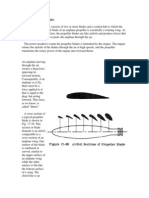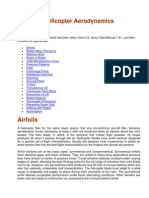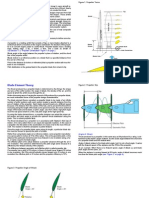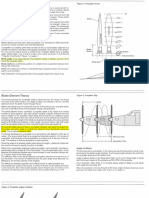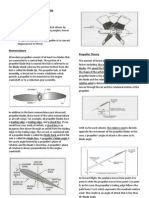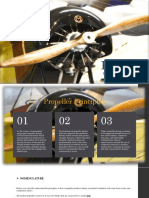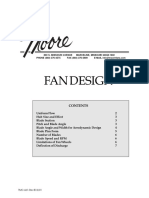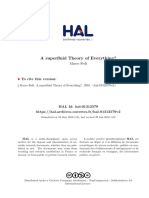Forces Acting On A Propeller: Transonic Scimitar Scimitar Propeller
Forces Acting On A Propeller: Transonic Scimitar Scimitar Propeller
Uploaded by
juanCopyright:
Available Formats
Forces Acting On A Propeller: Transonic Scimitar Scimitar Propeller
Forces Acting On A Propeller: Transonic Scimitar Scimitar Propeller
Uploaded by
juanOriginal Description:
Original Title
Copyright
Available Formats
Share this document
Did you find this document useful?
Is this content inappropriate?
Copyright:
Available Formats
Forces Acting On A Propeller: Transonic Scimitar Scimitar Propeller
Forces Acting On A Propeller: Transonic Scimitar Scimitar Propeller
Uploaded by
juanCopyright:
Available Formats
There have been efforts to develop propellers for aircraft at high subsonic speeds.
[30] The
'fix' is similar to that of transonic wing design. The maximum relative velocity is kept as low
as possible by careful control of pitch to allow the blades to have large helix angles; thin
blade sections are used and the blades are swept back in a scimitar shape (Scimitar
propeller); a large number of blades are used to reduce work per blade and so circulation
strength; contra-rotation is used. The propellers designed are more efficient than turbo-fans
and their cruising speed (Mach 0.7–0.85) is suitable for airliners, but the noise generated is
tremendous (see the Antonov An-70 and Tupolev Tu-95 for examples of such a design).
Forces acting on a propeller[edit]
Forces acting on the blades of an aircraft propeller include the following. Some of these
forces can be arranged to counteract each other, reducing the overall mechanical stresses
imposed.[31][1]
Thrust bending
Thrust loads on the blades, in reaction to the force pushing the air backwards, act
to bend the blades forward. Blades are therefore often raked forwards, such that
the outward centrifugal force of rotation acts to bend them backwards, thus
balancing out the bending effects.
Centrifugal and aerodynamic twisting
A centrifugal twisting force is experienced by any asymmetrical spinning object. In
the propeller it acts to twist the blades to a fine pitch. The aerodynamic centre of
pressure is therefore usually arranged to be slightly forward of its mechanical
centreline, creating a twisting moment towards coarse pitch and counteracting the
centrifugal moment. However in a high-speed dive the aerodynamic force can
change significantly and the moments can become unbalanced.
Centrifugal
There have been efforts to develop propellers for aircraft at high subsonic speeds.[30] The
'fix' is similar to that of transonic wing design. The maximum relative velocity is kept as low
as possible by careful control of pitch to allow the blades to have large helix angles; thin
blade sections are used and the blades are swept back in a scimitar shape (Scimitar
propeller); a large number of blades are used to reduce work per blade and so circulation
strength; contra-rotation is used. The propellers designed are more efficient than turbo-fans
and their cruising speed (Mach 0.7–0.85) is suitable for airliners, but the noise generated is
tremendous (see the Antonov An-70 and Tupolev Tu-95 for examples of such a design).
Forces acting on a propeller[edit]
Forces acting on the blades of an aircraft propeller include the following. Some of these
forces can be arranged to counteract each other, reducing the overall mechanical stresses
imposed.[31][1]
Thrust bending
Thrust loads on the blades, in reaction to the force pushing the air backwards, act
to bend the blades forward. Blades are therefore often raked forwards, such that
the outward centrifugal force of rotation acts to bend them backwards, thus
balancing out the bending effects.
Centrifugal and aerodynamic twisting
A centrifugal twisting force is experienced by any asymmetrical spinning object. In
the propeller it acts to twist the blades to a fine pitch. The aerodynamic centre of
pressure is therefore usually arranged to be slightly forward of its mechanical
centreline, creating a twisting moment towards coarse pitch and counteracting the
centrifugal moment. However in a high-speed dive the aerodynamic force can
change significantly and the moments can become unbalanced.
Centrifugal
There have been efforts to develop propellers for aircraft at high subsonic speeds.[30] The
'fix' is similar to that of transonic wing design. The maximum relative velocity is kept as low
as possible by careful control of pitch to allow the blades to have large helix angles; thin
blade sections are used and the blades are swept back in a scimitar shape (Scimitar
propeller); a large number of blades are used to reduce work per blade and so circulation
strength; contra-rotation is used. The propellers designed are more efficient than turbo-fans
and their cruising speed (Mach 0.7–0.85) is suitable for airliners, but the noise generated is
tremendous (see the Antonov An-70 and Tupolev Tu-95 for examples of such a design).
Forces acting on a propeller[edit]
Forces acting on the blades of an aircraft propeller include the following. Some of these
forces can be arranged to counteract each other, reducing the overall mechanical stresses
imposed.[31][1]
Thrust bending
Thrust loads on the blades, in reaction to the force pushing the air backwards, act
to bend the blades forward. Blades are therefore often raked forwards, such that
the outward centrifugal force of rotation acts to bend them backwards, thus
balancing out the bending effects.
Centrifugal and aerodynamic twisting
A centrifugal twisting force is experienced by any asymmetrical spinning object. In
the propeller it acts to twist the blades to a fine pitch. The aerodynamic centre of
pressure is therefore usually arranged to be slightly forward of its mechanical
centreline, creating a twisting moment towards coarse pitch and counteracting the
centrifugal moment. However in a high-speed dive the aerodynamic force can
change significantly and the moments can become unbalanced.
Centrifugal
There have been efforts to develop propellers for aircraft at high subsonic speeds.[30] The
'fix' is similar to that of transonic wing design. The maximum relative velocity is kept as low
as possible by careful control of pitch to allow the blades to have large helix angles; thin
blade sections are used and the blades are swept back in a scimitar shape (Scimitar
propeller); a large number of blades are used to reduce work per blade and so circulation
strength; contra-rotation is used. The propellers designed are more efficient than turbo-fans
and their cruising speed (Mach 0.7–0.85) is suitable for airliners, but the noise generated is
tremendous (see the Antonov An-70 and Tupolev Tu-95 for examples of such a design).
Forces acting on a propeller[edit]
Forces acting on the blades of an aircraft propeller include the following. Some of these
forces can be arranged to counteract each other, reducing the overall mechanical stresses
imposed.[31][1]
Thrust bending
Thrust loads on the blades, in reaction to the force pushing the air backwards, act
to bend the blades forward. Blades are therefore often raked forwards, such that
the outward centrifugal force of rotation acts to bend them backwards, thus
balancing out the bending effects.
Centrifugal and aerodynamic twisting
A centrifugal twisting force is experienced by any asymmetrical spinning object. In
the propeller it acts to twist the blades to a fine pitch. The aerodynamic centre of
pressure is therefore usually arranged to be slightly forward of its mechanical
centreline, creating a twisting moment towards coarse pitch and counteracting the
centrifugal moment. However in a high-speed dive the aerodynamic force can
change significantly and the moments can become unbalanced.
Centrifugal
There have been efforts to develop propellers for aircraft at high subsonic speeds.[30] The
'fix' is similar to that of transonic wing design. The maximum relative velocity is kept as low
as possible by careful control of pitch to allow the blades to have large helix angles; thin
blade sections are used and the blades are swept back in a scimitar shape (Scimitar
propeller); a large number of blades are used to reduce work per blade and so circulation
strength; contra-rotation is used. The propellers designed are more efficient than turbo-fans
and their cruising speed (Mach 0.7–0.85) is suitable for airliners, but the noise generated is
tremendous (see the Antonov An-70 and Tupolev Tu-95 for examples of such a design).
Forces acting on a propeller[edit]
Forces acting on the blades of an aircraft propeller include the following. Some of these
forces can be arranged to counteract each other, reducing the overall mechanical stresses
imposed.[31][1]
Thrust bending
Thrust loads on the blades, in reaction to the force pushing the air backwards, act
to bend the blades forward. Blades are therefore often raked forwards, such that
the outward centrifugal force of rotation acts to bend them backwards, thus
balancing out the bending effects.
Centrifugal and aerodynamic twisting
A centrifugal twisting force is experienced by any asymmetrical spinning object. In
the propeller it acts to twist the blades to a fine pitch. The aerodynamic centre of
pressure is therefore usually arranged to be slightly forward of its mechanical
centreline, creating a twisting moment towards coarse pitch and counteracting the
centrifugal moment. However in a high-speed dive the aerodynamic force can
change significantly and the moments can become unbalanced.
Centrifugal
There have been efforts to develop propellers for aircraft at high subsonic speeds.[30] The
'fix' is similar to that of transonic wing design. The maximum relative velocity is kept as low
as possible by careful control of pitch to allow the blades to have large helix angles; thin
blade sections are used and the blades are swept back in a scimitar shape (Scimitar
propeller); a large number of blades are used to reduce work per blade and so circulation
strength; contra-rotation is used. The propellers designed are more efficient than turbo-fans
and their cruising speed (Mach 0.7–0.85) is suitable for airliners, but the noise generated is
tremendous (see the Antonov An-70 and Tupolev Tu-95 for examples of such a design).
Forces acting on a propeller[edit]
Forces acting on the blades of an aircraft propeller include the following. Some of these
forces can be arranged to counteract each other, reducing the overall mechanical stresses
imposed.[31][1]
Thrust bending
Thrust loads on the blades, in reaction to the force pushing the air backwards, act
to bend the blades forward. Blades are therefore often raked forwards, such that
the outward centrifugal force of rotation acts to bend them backwards, thus
balancing out the bending effects.
Centrifugal and aerodynamic twisting
A centrifugal twisting force is experienced by any asymmetrical spinning object. In
the propeller it acts to twist the blades to a fine pitch. The aerodynamic centre of
pressure is therefore usually arranged to be slightly forward of its mechanical
centreline, creating a twisting moment towards coarse pitch and counteracting the
centrifugal moment. However in a high-speed dive the aerodynamic force can
change significantly and the moments can become unbalanced.
Centrifugal
There have been efforts to develop propellers for aircraft at high subsonic speeds.[30] The
'fix' is similar to that of transonic wing design. The maximum relative velocity is kept as low
as possible by careful control of pitch to allow the blades to have large helix angles; thin
blade sections are used and the blades are swept back in a scimitar shape (Scimitar
propeller); a large number of blades are used to reduce work per blade and so circulation
strength; contra-rotation is used. The propellers designed are more efficient than turbo-fans
and their cruising speed (Mach 0.7–0.85) is suitable for airliners, but the noise generated is
tremendous (see the Antonov An-70 and Tupolev Tu-95 for examples of such a design).
Forces acting on a propeller[edit]
Forces acting on the blades of an aircraft propeller include the following. Some of these
forces can be arranged to counteract each other, reducing the overall mechanical stresses
imposed.[31][1]
Thrust bending
Thrust loads on the blades, in reaction to the force pushing the air backwards, act
to bend the blades forward. Blades are therefore often raked forwards, such that
the outward centrifugal force of rotation acts to bend them backwards, thus
balancing out the bending effects.
Centrifugal and aerodynamic twisting
A centrifugal twisting force is experienced by any asymmetrical spinning object. In
the propeller it acts to twist the blades to a fine pitch. The aerodynamic centre of
pressure is therefore usually arranged to be slightly forward of its mechanical
centreline, creating a twisting moment towards coarse pitch and counteracting the
centrifugal moment. However in a high-speed dive the aerodynamic force can
change significantly and the moments can become unbalanced.
Centrifugal
There have been efforts to develop propellers for aircraft at high subsonic speeds.[30] The
'fix' is similar to that of transonic wing design. The maximum relative velocity is kept as low
as possible by careful control of pitch to allow the blades to have large helix angles; thin
blade sections are used and the blades are swept back in a scimitar shape (Scimitar
propeller); a large number of blades are used to reduce work per blade and so circulation
strength; contra-rotation is used. The propellers designed are more efficient than turbo-fans
and their cruising speed (Mach 0.7–0.85) is suitable for airliners, but the noise generated is
tremendous (see the Antonov An-70 and Tupolev Tu-95 for examples of such a design).
Forces acting on a propeller[edit]
Forces acting on the blades of an aircraft propeller include the following. Some of these
forces can be arranged to counteract each other, reducing the overall mechanical stresses
imposed.[31][1]
Thrust bending
Thrust loads on the blades, in reaction to the force pushing the air backwards, act
to bend the blades forward. Blades are therefore often raked forwards, such that
the outward centrifugal force of rotation acts to bend them backwards, thus
balancing out the bending effects.
Centrifugal and aerodynamic twisting
A centrifugal twisting force is experienced by any asymmetrical spinning object. In
the propeller it acts to twist the blades to a fine pitch. The aerodynamic centre of
pressure is therefore usually arranged to be slightly forward of its mechanical
centreline, creating a twisting moment towards coarse pitch and counteracting the
centrifugal moment. However in a high-speed dive the aerodynamic force can
change significantly and the moments can become unbalanced.
Centrifugal
There have been efforts to develop propellers for aircraft at high subsonic speeds.[30] The
'fix' is similar to that of transonic wing design. The maximum relative velocity is kept as low
as possible by careful control of pitch to allow the blades to have large helix angles; thin
blade sections are used and the blades are swept back in a scimitar shape (Scimitar
propeller); a large number of blades are used to reduce work per blade and so circulation
strength; contra-rotation is used. The propellers designed are more efficient than turbo-fans
and their cruising speed (Mach 0.7–0.85) is suitable for airliners, but the noise generated is
tremendous (see the Antonov An-70 and Tupolev Tu-95 for examples of such a design).
Forces acting on a propeller[edit]
Forces acting on the blades of an aircraft propeller include the following. Some of these
forces can be arranged to counteract each other, reducing the overall mechanical stresses
imposed.[31][1]
Thrust bending
Thrust loads on the blades, in reaction to the force pushing the air backwards, act
to bend the blades forward. Blades are therefore often raked forwards, such that
the outward centrifugal force of rotation acts to bend them backwards, thus
balancing out the bending effects.
Centrifugal and aerodynamic twisting
A centrifugal twisting force is experienced by any asymmetrical spinning object. In
the propeller it acts to twist the blades to a fine pitch. The aerodynamic centre of
pressure is therefore usually arranged to be slightly forward of its mechanical
centreline, creating a twisting moment towards coarse pitch and counteracting the
centrifugal moment. However in a high-speed dive the aerodynamic force can
change significantly and the moments can become unbalanced.
Centrifugal
You might also like
- Voltage Drop For Street Light PoleDocument3 pagesVoltage Drop For Street Light Polesuresh babuNo ratings yet
- Auto Transformer StarterDocument9 pagesAuto Transformer Starterdiana100% (3)
- Helicopter Aerodynamics by Paul CantrellDocument57 pagesHelicopter Aerodynamics by Paul CantrellAbhiram100% (2)
- CAIP Vol II PropellersDocument32 pagesCAIP Vol II PropellersSHM 555No ratings yet
- Aircraft Propeller: Submitted TO-Gagan Varshney Submitted BY - Abdullah RaghibDocument26 pagesAircraft Propeller: Submitted TO-Gagan Varshney Submitted BY - Abdullah RaghibAbdullah Raghib SiddiquiNo ratings yet
- Aerm Notes3Document7 pagesAerm Notes3Jabez RichardsNo ratings yet
- Propellers PrintDocument17 pagesPropellers Printrizkykusumastuti112No ratings yet
- Basic Propeller PrinciplesDocument7 pagesBasic Propeller Principlesmgskumar100% (1)
- Easa Propellers QuestionsDocument8 pagesEasa Propellers QuestionsHongshuangLee0% (1)
- Notes Helicopter AerodynamicsDocument44 pagesNotes Helicopter Aerodynamicsyenikesuryaprakash100% (2)
- Mike Burton PropellersDocument103 pagesMike Burton Propellerss gNo ratings yet
- Propeller Aerodynamics PDFDocument11 pagesPropeller Aerodynamics PDFMaurizio Bernasconi100% (2)
- Propeller Theory: Baldoz, Lowell T. Briz, Mac Arman BDocument25 pagesPropeller Theory: Baldoz, Lowell T. Briz, Mac Arman BMak Briz100% (2)
- Propeller FundamentalDocument7 pagesPropeller FundamentalSharath UpadhyaNo ratings yet
- PropellerDocument252 pagesPropellerAhmadFaisal100% (4)
- 105 - Do Centre-Bodies Improve The Performance of Horizontal-Axis, Sail-Type Wind-TurbinesDocument8 pages105 - Do Centre-Bodies Improve The Performance of Horizontal-Axis, Sail-Type Wind-TurbinesMayra ZezattiNo ratings yet
- Ho 17.1.1Document14 pagesHo 17.1.1yaman91No ratings yet
- Aerodynamics of Wind Turbines: Part - 3Document37 pagesAerodynamics of Wind Turbines: Part - 3John TauloNo ratings yet
- The Compound Helicopter Configuration and TheDocument7 pagesThe Compound Helicopter Configuration and Theghoopp76No ratings yet
- Aircraft PropellerDocument97 pagesAircraft Propellerzaidkadiri9No ratings yet
- M17 NoteDocument63 pagesM17 Noteshanthini01011986No ratings yet
- Helicopter FundamentalsDocument66 pagesHelicopter FundamentalsYuvaraj Tingiri100% (3)
- Propeller 2Document194 pagesPropeller 2Umar Ubaidullah100% (2)
- Chapter 12 - PropellersDocument22 pagesChapter 12 - PropellersRezwan Ahmed KhanNo ratings yet
- 300 Review Questions 1701385421971 0Document42 pages300 Review Questions 1701385421971 0minfuelNo ratings yet
- Propeller AerodynamicsDocument6 pagesPropeller AerodynamicsMuhammedNayeemNo ratings yet
- Aircraft PropplerDocument25 pagesAircraft PropplerSajjad ShamimNo ratings yet
- Lecture 2Document26 pagesLecture 2moezzbomb100% (1)
- Propeller TheoryDocument9 pagesPropeller TheoryFlorenceNo ratings yet
- Critical Mach Number, Transonic Area RuleDocument11 pagesCritical Mach Number, Transonic Area RuleGurunath Aero100% (2)
- Module 2 18AE43Document8 pagesModule 2 18AE43Kushal SinghNo ratings yet
- USARM 405 Propeller QUESTION BANKDocument30 pagesUSARM 405 Propeller QUESTION BANKPathan FatimaNo ratings yet
- AEMR-Unit - II & III, 2 Marks & 16 Marks Questions With Anwers-IV Yr AeroDocument39 pagesAEMR-Unit - II & III, 2 Marks & 16 Marks Questions With Anwers-IV Yr AeroRAJASUDHAKAR SNo ratings yet
- RegulationsDocument19 pagesRegulationsDuruthu AbhishekNo ratings yet
- Ropeller Erodynamics: Propeller AerodynamicsDocument5 pagesRopeller Erodynamics: Propeller AerodynamicstarabhmallyNo ratings yet
- Effect of Propeller On Airplane Dynamics: Yawing Moments and SideslipDocument6 pagesEffect of Propeller On Airplane Dynamics: Yawing Moments and SidesliphydraumanNo ratings yet
- Amt 113 Hand Outs NewDocument5 pagesAmt 113 Hand Outs NewicayieNo ratings yet
- Propellers 12th ChapterDocument72 pagesPropellers 12th ChapterJohn Kevin100% (1)
- Mod 17 Book 1 Propeller Systems Theory & ConstructionDocument86 pagesMod 17 Book 1 Propeller Systems Theory & Constructionranjit prasadNo ratings yet
- Lecture 03-Basic of Fluid Mechanics in Wind TurbinesDocument35 pagesLecture 03-Basic of Fluid Mechanics in Wind TurbinesFaraz AhmadNo ratings yet
- Propeller (PRELIMS LESSON)Document34 pagesPropeller (PRELIMS LESSON)Aidrian AidNo ratings yet
- Propeller SystemsDocument45 pagesPropeller SystemsAma Serwaa YeboahNo ratings yet
- Wind Turbine Design For Wind PowerDocument7 pagesWind Turbine Design For Wind Powermuhammad husnainNo ratings yet
- Write Up For Main Rotor System Edited FinalDocument13 pagesWrite Up For Main Rotor System Edited FinalSean Andrew Conti MagadiaNo ratings yet
- Design Aspects of Wind BladesDocument9 pagesDesign Aspects of Wind BladesMahesh SawantNo ratings yet
- Helicopter RotorDocument14 pagesHelicopter RotorRoshith Nair100% (1)
- Helicopter RotorDocument18 pagesHelicopter RotorAswin Harippad100% (2)
- Moore Fan 02Document7 pagesMoore Fan 02vikramNo ratings yet
- Propeller NewDocument12 pagesPropeller NewMaruf AminNo ratings yet
- Aircraft PropellerDocument120 pagesAircraft Propelleraerogem618100% (4)
- Marine Propellers: 2.016 HydrodynamicsDocument19 pagesMarine Propellers: 2.016 HydrodynamicsMol MolNo ratings yet
- EASA Module 17Document134 pagesEASA Module 17Kushlan Sanka Fernando90% (10)
- Questions Modeling Control and Design of Wind Energy Systems658Document14 pagesQuestions Modeling Control and Design of Wind Energy Systems658waltikraNo ratings yet
- Wind Turbine Blade AerodynamicsDocument10 pagesWind Turbine Blade AerodynamicsMahesh MunjalNo ratings yet
- Illustrated Sail & Rig Tuning: Genoa & mainsail trim, spinnaker & gennaker, rig tuningFrom EverandIllustrated Sail & Rig Tuning: Genoa & mainsail trim, spinnaker & gennaker, rig tuningRating: 3.5 out of 5 stars3.5/5 (2)
- Modeling of Complex Systems: Application to Aeronautical DynamicsFrom EverandModeling of Complex Systems: Application to Aeronautical DynamicsNo ratings yet
- M1 Lab ReportDocument6 pagesM1 Lab Reportweimingf0% (2)
- Instruction Manual FOR Energy Storage Device Model: ESD 202 Part Number: 9 2905 00 100Document2 pagesInstruction Manual FOR Energy Storage Device Model: ESD 202 Part Number: 9 2905 00 100govindarulNo ratings yet
- A Linear-Programming Approximation of AC Power Flows: Carleton Coffrin, Member, IEEE, Pascal Van Hentenryck, Member, IEEEDocument13 pagesA Linear-Programming Approximation of AC Power Flows: Carleton Coffrin, Member, IEEE, Pascal Van Hentenryck, Member, IEEEGabor PeterNo ratings yet
- Regulador Basler VR6Document4 pagesRegulador Basler VR6Manuel OteroNo ratings yet
- ABB Contactor RelaysDocument17 pagesABB Contactor RelaysAparna Akhilesh100% (1)
- Electrical System Design AnalysisDocument4 pagesElectrical System Design AnalysisEdmar BataqueNo ratings yet
- 3a20 ApplicationDocument15 pages3a20 ApplicationbansalrNo ratings yet
- Refurbishment Power Engieneeting Electrical LappiesDocument5 pagesRefurbishment Power Engieneeting Electrical LappiesMohd AzlanNo ratings yet
- Ce SubjectsDocument68 pagesCe SubjectsCamille Garcia100% (1)
- General Power Quality IssueDocument3 pagesGeneral Power Quality IssueRizwan 106No ratings yet
- Piezoelectric Transducer PDFDocument2 pagesPiezoelectric Transducer PDFSri Vishnu ThatiNo ratings yet
- Power System Protection and Control - 1Document5 pagesPower System Protection and Control - 1Pratik Jones KhobragadeNo ratings yet
- Physics For Scientists Engineers With Modern Physics Volume 3 Chapters 36 44 Fourth Edition, Pearson New International Edition GiancoliDocument70 pagesPhysics For Scientists Engineers With Modern Physics Volume 3 Chapters 36 44 Fourth Edition, Pearson New International Edition Giancoliwarsanpatoo100% (13)
- UPSDocument8 pagesUPSMohammed Sayeeduddin100% (1)
- Getting Started 1-1: GEK-113064B HID High Impedance Differential Module 1-1Document22 pagesGetting Started 1-1: GEK-113064B HID High Impedance Differential Module 1-1احمدرضاNo ratings yet
- 18Document3 pages18Ilyas PaghdiwalaNo ratings yet
- Manual de Centrifuga IEC CL2Document36 pagesManual de Centrifuga IEC CL2JAPHETNo ratings yet
- Mechanics Ad2Document31 pagesMechanics Ad2kamlesh kumarNo ratings yet
- Fedi Superfluid ToE v2Document38 pagesFedi Superfluid ToE v2Milan PetrikNo ratings yet
- Lesson1 Units and Measurements TBPDocument37 pagesLesson1 Units and Measurements TBPSapphire RedNo ratings yet
- Parallel OperationDocument4 pagesParallel Operationashad ashaNo ratings yet
- Er-Xx and Erv-Xx Timer RelaysDocument1 pageEr-Xx and Erv-Xx Timer RelayszainahmedscribdNo ratings yet
- Bhairav Thakkar MosDocument33 pagesBhairav Thakkar MosAnonymous bg4BXjfrJNo ratings yet
- Adjustable Frequency AC Drive: FRN 2.xxDocument94 pagesAdjustable Frequency AC Drive: FRN 2.xxkaimissNo ratings yet
- Cooling of The Electric Propulsor of A Formula Student VehicleDocument10 pagesCooling of The Electric Propulsor of A Formula Student VehicleAshraf EmadNo ratings yet
- National Institute of Technology Rourkela Mid - Semester Examination, 2019Document2 pagesNational Institute of Technology Rourkela Mid - Semester Examination, 2019abhishekNo ratings yet
- CCL Structural Bearings Brochure LR PDFDocument20 pagesCCL Structural Bearings Brochure LR PDFGouzal Hamza100% (1)
- Short-Time Current Rating of Conductor - Time CalculationDocument2 pagesShort-Time Current Rating of Conductor - Time CalculationFady MegalaNo ratings yet








